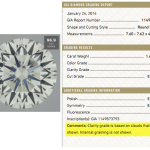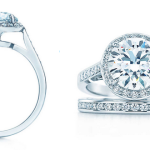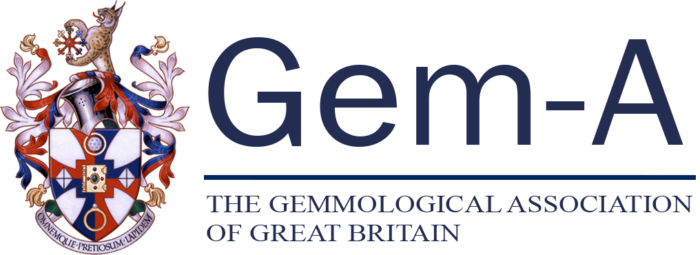Diamond Grading Reports
GIA vs. AGS Cut Grades
Diamond grading reports help to describe a diamond’s many characteristics including: carat weight, clarity, color, basic cut proportions, fluorescence, and overall polish and symmetry. It’s beneficial to always purchase a diamond with a lab report because:
1. They confirm that a diamond is of the quality level that you are being asked to pay for.
2. They help for verification purposes in cases where you need to get your jewelry repaired.
3. Diamonds with respected lab reports are worth more and are thus easier to resell.
Some of the more popular diamond laboratories issue grading reports and certificates all over the world. Some of these include:
– Gemological Institute of America (GIA) – a non-profit institute that created the “four Cs” (Cut, Color, Clarity and Carat Weight) methodology of grading diamonds and the International Diamond Grading System. GIA issues ‘reports’ not certifications.
– American Gem Society (AGS) – original lab to provide diamond cut grades (ranging from 0-10, with 0 being termed “ideal”).
– European Gemological Laboratory (EGL) – an independent network of grading laboratories. Grading standards vary from one EGL laboratory to another. (12/3/2014 – EGL has shut down and is reorganizing due to controversy of inconsistent grading practices)
– International Gemological Institute (IGI) – Biggest lab by quantity. Most IGI graded stones are sold in traditional brick and mortar stores.
– Hoge Raad voor Diamant (HRD) – Belgian institution in Antwerp and Europe’s GIA equivalent; grading certificates are more common in the Far East and Europe and also serve as legal documents in the European Union.
However, the growth of online diamond selling has created a need for more and more buyers to rely on more than just grading reports to make purchasing decisions. There is still a lot of information that is omitted from a diamond lab report, such as:
Diamond “Make” – Refers to how well a stone is cut and faceted. This is important because it has a direct affect on a diamond’s overall beauty. For example, diamonds with large or small tables and low or high crowns are cut differently and show different visual characteristics and light performance. Diamonds with different “makes” show different visual performance but they may all fall within a single cut grade from a particular lab.
Diamond “Performance” – Refers to a diamond’s visual properties that include: brightness, contrast, scintillation, dispersion, and light leakage. Each ‘make’ of a diamond will result in different visual properties. Most labs will have categorized different visual properties within the same cut grade and thus it is important to use tools like AGS ASET (Angular Spectrum Evaluation Technology/Tool) to discern a diamond’s interaction with light.
Diamond “Precision” – Refers to how well a diamond’s facets align in a 3D illustration. A diamond that is cut to precise proportions and high precision often boost contrast and show more visible dispersion and scintillation. On the other hand, a chaotic patterning of facets that is not aligned can look random and less vibrant. Different facet patterns affect how a diamond looks but can be issued the same cut grade.
This is why it is very possible to have diamonds of different makes, performance, and patterning all graded upon the same cut grade. This shows that not all Excellent Cut or Ideal Cut diamonds are the same and must be evaluated on a case by case basis with other diamond assessment tools.
Gemological Institute of America
GIA is one of the best diamond grading laboratories in the world due to their reliable and stringent grading standards. Founded in 1931, GIA maintains its non-profit roots and continues to grow in technological innovation to maintain the highest standards in education, research, lab services, and instrument development. Some of their most notable achievements have been found in the development of the now industry standard D-Z color scale and Flawless-I3 clarity scale, detecting fracture filled diamonds, and identifying the affect of fluorescence on a diamond’s appearance.
In 2006, GIA issued a 5-grade, proportion-based quality system for round brilliant colorless diamonds for the first time. This new scheme relies upon a 2-dimensional system to determine a diamond’s cut grade. As a result, GIA lab reports not only include the usual crown and pavilion angles but also lower girdle and star facet information.
However, this new addition to GIA’s grading has also become an industry wide downfall. Many have criticised GIA for being too lenient on deeper and steeper cut stones which can be a direct disadvantage to many retailers and consumer’s relying upon GIA’s “Excellent” cut specifications. In other words, GIA’s “excellent” cut grade includes a very wide range of cut parameters with around 50% of the diamonds submitted to the lab getting this cut grade.
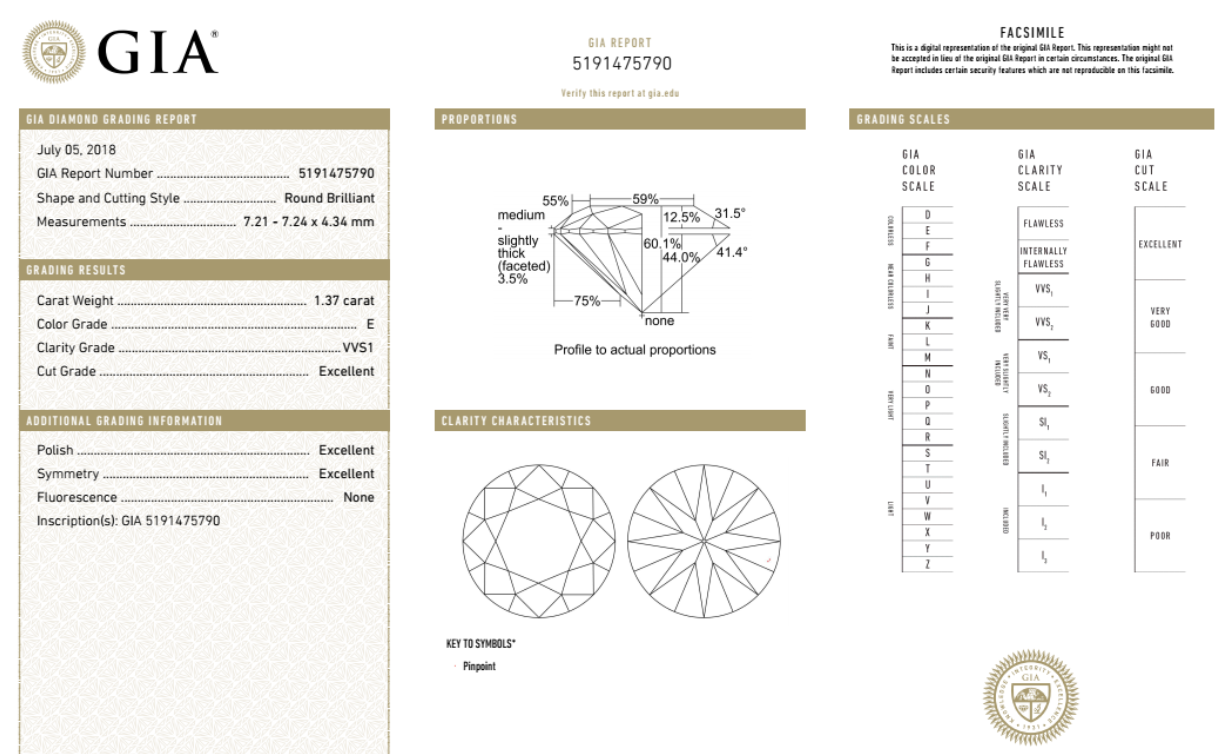
Since GIA has come out with their new cut grade parameters (in 2006), many diamond cutters are using this to their advantage. For example, diamond cutters are knowingly cutting stones to the maximum possible weight that is acceptable within the “excellent” weight grade while still maintaining the price premium for an excellent graded stone. And remember, a GIA excellent cut stone has nothing to do with hearts and arrows symmetry; which is an entirely different subject pertaining to specific cut and facet proportions.
American Gem Society Laboratories
Although GIA “Excellent” cut grade is still considered an elite grading, it is important to know that the American Gem Society (AGS) cut grading system uses a more advanced 3-dimensional system to determine a diamond’s cut. Additionally, AGS utilizes human analysis, angular spectrum evaluation technology (ASET), and optical physics ray-tracing software to determine the quantity and quality of light that is returned to the observer (in motion as well as in a face-up static position).
All of these tools help to give AGS an overall summary of the interaction of light within any given diamond and therefore is used to determine if a diamond’s cut is AGS “Ideal Light Performance” grade. Because the AGS cut evaluation process is very stringent and exact, (given to less than 1% of all diamonds in shapes where cut is graded), the AGS 0 ‘Ideal’ grade is the world’s strictest laboratory standard for cut.
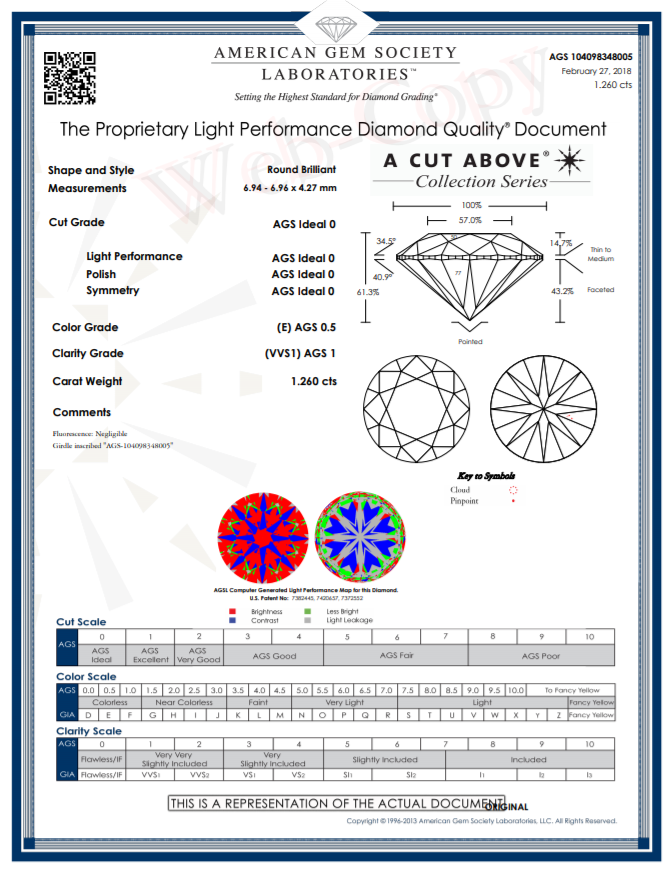
This is an example of an AGS diamond grading report. Note the red ASET image. This vital piece of information shows the expected “light performance” on a given stone. Red is the most desirable color in any ASET image as it indicates high light reflection. Blue represents contrast and Green is lower intensity light reflection. This particular diamond is a A Cut Above super ideal hearts and arrows diamond offered by Whiteflash.
What Does All This Mean To The Diamond Consumer?
– GIA’s cut grade system is based on proportions and is not advanced enough to assess individual diamonds on an individual basis (like AGS does).
– GIA also issues deductions for finish factors of polish and symmetry that has resulted in the penalization of some super-ideal diamonds that have no known light performance issues.
– The top GIA cut grade, “Excellent,” overlaps several AGS cut grades.
– GIA allows for the cut grade to have wider range allowing for diamonds with proportions that are farther away from Tolkowsky’s Ideal cut. This includes a number of steep/deep diamond combinations that can make a diamond look smaller than its carat weight implies. This can also result in significant light leakage.
Which Lab Is Best?
Undeniably GIA has the largest global reputation for consistent high quality reports, and is known for their strictness in color, clarity and finish grading (while allowing more freedom in their cut grades). Since GIA caters to a more global taste in certified diamonds, it makes sense that their wide cut grade is appealing and available for different markets.
AGS on the other hand provides a service to consumers that is more boutique with a more narrow margin in cut grade parameters. Diamonds that receive the AGS ideal grade were more likely sent there because the manufacturer was confident enough to know it would receive this high pedigree. More than 97% of all diamonds fail to meet AGS 0 “Ideal” cut requirements and that is perhaps why many commercial diamonds are sent to labs with more lenient cut grading or perhaps no cut grade at all. If you are buying a diamond online then AGS is preferred as it is the world’s strictest laboratory standard for cut.
No matter which diamond lab you prefer, as people become more informed and educated they develop higher expectations and demand more qualitative tools in order to discern a diamonds quality and value. The old paradigm of how diamonds were previously bought and sold in the retail market is changing. Savvy diamond buyers are now taking advantage of qualitative analysis tools such as microscopic photographs, Ideal-Scope, ASET and cut reports that all contribute to provide a comprehensive overview of a diamond’s symmetry, light performance and transparency. Cutting edge diamond vendors are providing this information to informed buyers. It is no longer necessary to “see” a diamond in person as long as you have these important tools by your side to help make the best diamond buying decision for you.
ODBA Recommends
You May Also Like




